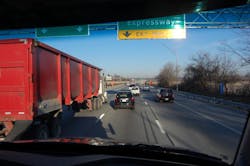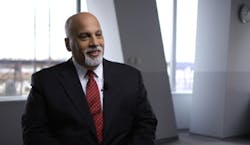In the big rig world, “danger” presents itself in myriad forms: bad weather, traffic congestion, crashes, cargo theft, equipment failures, spiraling diesel prices … the list is endless.
From a broader business perspective, though, there are bigger risks on the horizon that could generate heavy fallout for the trucking industry; with tighter government regulations and declining economic growth being just two of larger ones.
To make matters more complicated, the potential impact posed by such risks is becoming all the more grater as businesses worldwide are “transforming” themselves in order to become leaner and more nimble, according to a new survey conducted by PricewaterhouseCoopers (PwC).
PwC recently published a report entitled Global risk in the transformation age, based on a survey of more than 800 executives and risk managers in businesses worldwide.
The global consulting firm noted that more than two-thirds of companies have undergone a major transformation in the past 18 months, with another 10% plan to do so over the next 18 to 24 months, as corporations large and small build new business models, tap into digital channels, and expand into new geographic markets, all while rethinking how their supply chains and the location of their facilities fit into their globalization strategies.Yet Dean Simone (at left), leader of PwC's US Risk Assurance practice, said the concern is that as companies continue to transform their businesses to succeed in today's fast-changing global environment, they are increasingly worried about growing “external market risks” that can derail their strategic priorities; risks that take dead-aim at trucking-related operations as well, one should note.
"Continued recessionary pressures, global financial shocks, increased taxation and excessive government austerity are top-of-mind risks for board members and executives because of the serious impact they can have on businesses," Simone pointed out in the report.
"Changes in business direction have also exposed companies to new risks, and the interplay of market and business transformation is creating complex risk linkages that can be fragile and difficult to predict,” he explained. “This complexity requires businesses to rethink their approach by taking a holistic, multifunctional view of managing risk.”
Here are some of the big ones:
- A major global economic downturn is again seen as the most serious risk over the next 18 months, and nearly two-thirds of PwC's survey respondents cited such a downturn as being likely. PwC's 16th Annual Global CEO Survey reflected this sentiment, with 81% of respondents being somewhat or extremely concerned about economic uncertainty, and nearly a third expressing worries about a U.S. recession.
- Executives are most apprehensive about increased taxation in industrialized markets, which two-thirds consider a probable event with serious consequences. Similarly, about half of respondents view excessive government austerity measures as a powerful threat, particularly as more nations move to reduce their heavy debt burdens.
- Close to 60% of those executives polled said “business transformation” will make their companies more vulnerable to technology risks. The danger that major information technology (IT) programs will fail to deliver expected benefits is the biggest specific risk cited by survey respondents.
- More than 40% of survey respondents say social media is likely to put them at risk in the next 18 months.
- Almost half of the survey respondents are concerned that entering new geographies and markets will expose them to further risks, particularly regulatory compliance risks.
- More than 62% cite risks arising from organizational change and restructuring as a key hazard of business transformation, since reorganizations can go wrong or cause unexpected consequences. Similarly, more than half of respondents cite the failures of new strategies and business ventures as key risks.
Simone argued that in today's “unpredictable environment,” companies need techniques to anticipate unknown risks, as well as structures that are resilient to risks when and where they occur.
[You can watch him touch on this subject in the video below.]
"Businesses can use horizon scanning and early-warning systems to spot trends, and employ stress testing to identify key vulnerabilities,” he explained. “More flexible risk appetite statements, corporate-wide contingency planning and a risk-aware corporate culture that challenges conventional wisdom are all powerful tools that can help organizations better manage emerging risks."
To that end, PwC discerned that there are four strategic “response categories” in which businesses can bolster techniques designed to address risk arising from both market and business transformation:
- Resilience: Companies are pushing harder to build resilience to emerging risks. Over the next 18 months, more than half of responding companies will be applying horizon scanning, early-warning systems, scenario planning and flexible risk appetite statements.
- People: More companies are taking organizational measures such as developing risk-related performance incentives and conducting talent audits to identify skills gaps. PwC's survey respondents plan increases of 79% and 69%, respectively, in their use of these measures.
- Technology: To address growing risks from digital technology and social media, companies will nearly double their use of intellectual property, brand and reputation audits over the next 18 months and take measures to mitigate the risks that are uncovered.
- Next-generation risk analytics: Across industries, companies will draw on more sophisticated techniques to identify hidden patterns and risk linkages in large sets of data. The fastest growing tools will include integrated risk data warehouses (whose use is expected to double) and risk dashboards (whose use will increase by 50%).
Not everything above is something truckers can or should deploy. But they do offer good food for thought as risks of all sorts continues to rise across the freight landscape.





